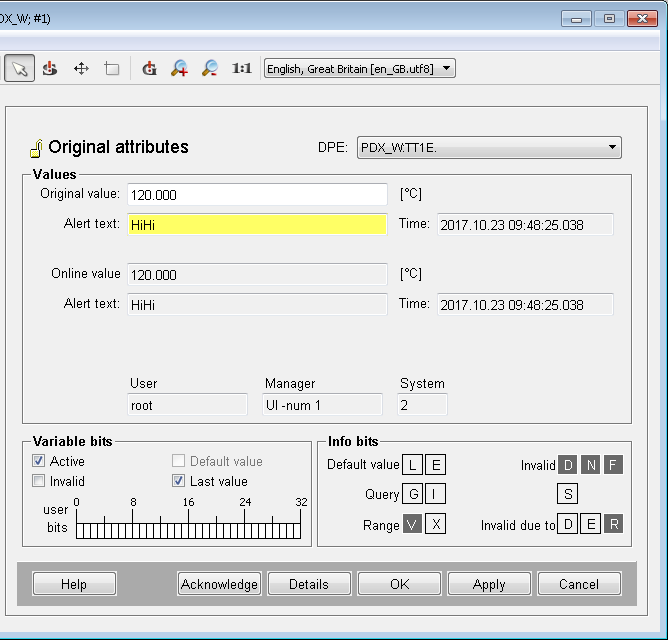Hi,
I can't find a specific explanation of this anywhere.
What is the best way to approach analog out of range alarms? Set up a WinCC OA value range on the dp & then create another alarm dp which is triggered by the _out_range attribute of the analog? Is there a way to do this all within the analog dp?
Analog Out of Range
- ozangor
- Posts:44
- Joined: Thu Sep 22, 2011 2:57 pm
Re: Analog Out of Range
I think it's better to add an alert handler to your analog dpe, and set the range limits to generate alarms.
- ewoenne
- Posts:62
- Joined: Thu May 12, 2016 10:35 am
Re: Analog Out of Range
Thanks for your reply. I did try that & got slightly strange results:
I have an alarm set up with the folllowing
- normal range
- hi range (low priority)
- hihi range (medium priority)
- OOR, above hihi range (low priority)
When the value is out of range, the alarm displays in the alarms list but the para still shows the text and colour of the hihi alarm.
I have an alarm set up with the folllowing
- normal range
- hi range (low priority)
- hihi range (medium priority)
- OOR, above hihi range (low priority)
When the value is out of range, the alarm displays in the alarms list but the para still shows the text and colour of the hihi alarm.
- ozangor
- Posts:44
- Joined: Thu Sep 22, 2011 2:57 pm
Re: Analog Out of Range
I tried it with a simple float datapoint. It seems to work fine. Can you please post screenshots of your _alert_hdl and _pv_range configs?
In _pv_range do you have the checkbox ticked before "Ignore values otside of value range"? This will prevent the datapoint element to have values out of range. However, in this case you should not be seeing the alarm in the alarm list.
And check your _alert_class configs for the used alarm classes. You may need to set the acknowledgment type to something that would work for you.
Do you have _default config defined for your datapoint?
In _pv_range do you have the checkbox ticked before "Ignore values otside of value range"? This will prevent the datapoint element to have values out of range. However, in this case you should not be seeing the alarm in the alarm list.
And check your _alert_class configs for the used alarm classes. You may need to set the acknowledgment type to something that would work for you.
Do you have _default config defined for your datapoint?
- ewoenne
- Posts:62
- Joined: Thu May 12, 2016 10:35 am
- ozangor
- Posts:44
- Joined: Thu Sep 22, 2011 2:57 pm
Re: Analog Out of Range
I can't see any screenshots, Ellen :/
Oh, I see them now.
I could not see a problem in the configuration here. Which version/patch of WCCOA do you have?
Oh, I see them now.
I could not see a problem in the configuration here. Which version/patch of WCCOA do you have?
- ewoenne
- Posts:62
- Joined: Thu May 12, 2016 10:35 am
Re: Analog Out of Range
We're using v3.15 patch 6
- ozangor
- Posts:44
- Joined: Thu Sep 22, 2011 2:57 pm
Re: Analog Out of Range
I tested it with the same version.
How does it behave if you change the upper-value limit to a larger value? Does your alert color update in that case?
How does it behave if you change the upper-value limit to a larger value? Does your alert color update in that case?
- ewoenne
- Posts:62
- Joined: Thu May 12, 2016 10:35 am
Re: Analog Out of Range
Sorry, which value did you want me to test?
I think the problem is with the alarm classes as the OOR is a lower priority than the HiHi:
OOR - low class priority 20
HiHi - medium class priority 40
Hi - low class priority 20
If I test it with all ranges as the same alarm class I get the correct text (OOR when the value is > 100)
I think the problem is with the alarm classes as the OOR is a lower priority than the HiHi:
OOR - low class priority 20
HiHi - medium class priority 40
Hi - low class priority 20
If I test it with all ranges as the same alarm class I get the correct text (OOR when the value is > 100)
- Gertjan van Schijndel
- Posts:634
- Joined: Mon Aug 02, 2010 10:37 am
Re: Analog Out of Range
Ellen Woenne wrote:
Also 120.0 is bigger than 50.0, so the highest priority is used.
The discrete alert handling must not be used with float element types, otherwise you could have used this and specified the value ranges and/or the value out of range state bit.
That is the correct conclusion. The documentation contains this statement regarding the continuous alert handling: The alert classes have to be assigned according to increasing priority.I think the problem is with the alarm classes as the OOR is a lower priority than the HiHi:
Also 120.0 is bigger than 50.0, so the highest priority is used.
The discrete alert handling must not be used with float element types, otherwise you could have used this and specified the value ranges and/or the value out of range state bit.


